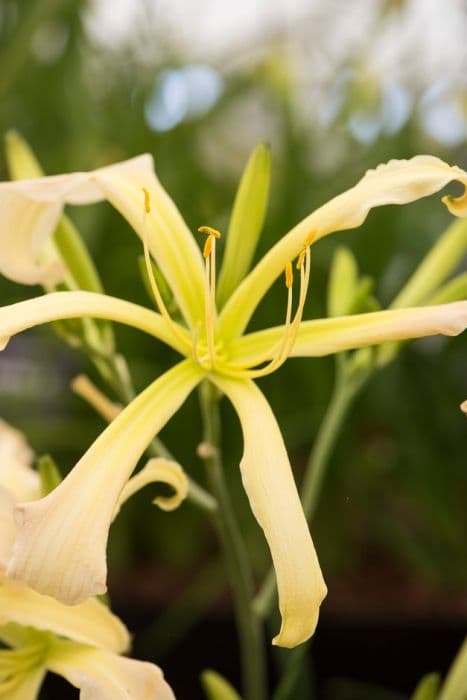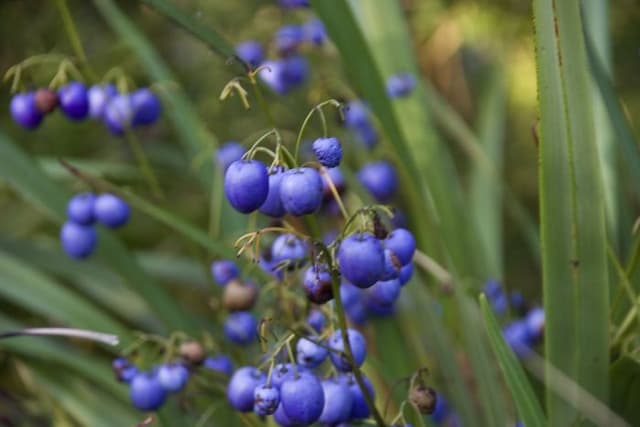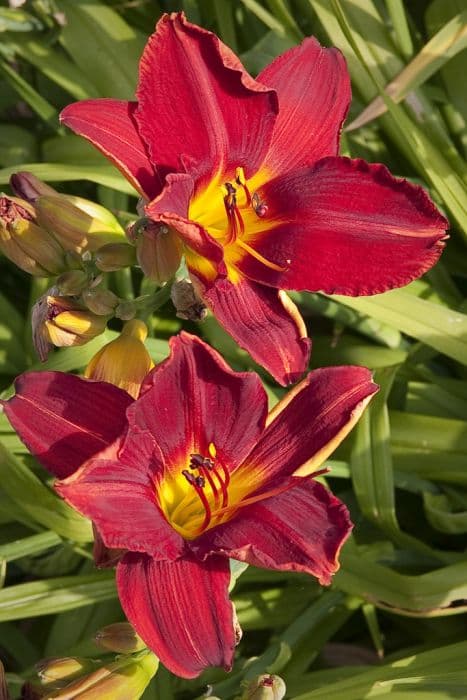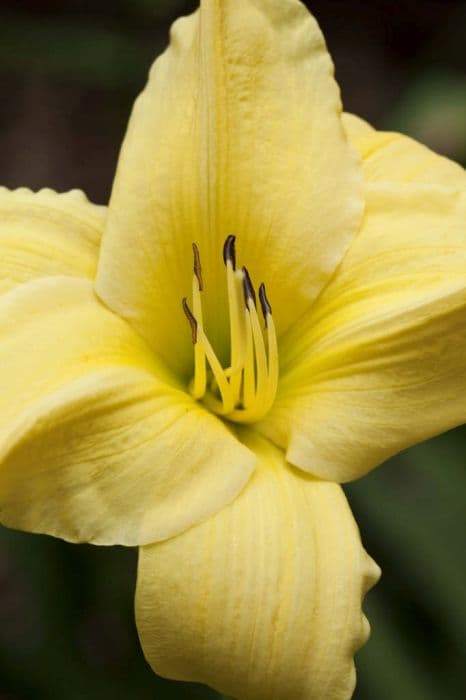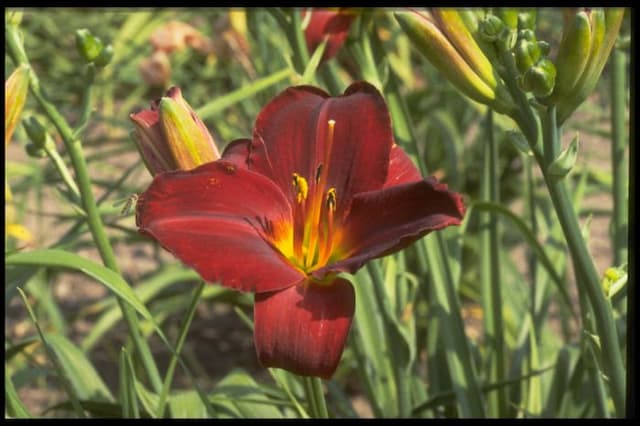Daylily Hemerocallis fulva

ABOUT
The plant known commonly as the daylily is recognized by its distinctive flowers and foliage. This perennial bears long, blade-like leaves that grow in clumps, presenting a lush, green base from which the flowers emerge. The flowers themselves are trumpet-shaped, boasting a vibrant orange color that can infuse life into any garden setting. These blossoms typically have six petals and can have a slightly ruffled appearance at their edges. Inside the petals, the throat of the flower often features a deeper orange hue, creating a beautiful gradient of color. Each individual flower blooms for just a day, with several buds on each flower stalk ensuring a succession of flowers during the blooming period. The daylily tends to bloom in midsummer, presenting a striking display when many appear together in full bloom.
About this plant
 Names
NamesFamily
Hemerocallidaceae
Synonyms
Common Daylily, Tawny Daylily, Orange Daylily, Ditch Lily, Roadside Daylily, Tiger Daylily, Fulvous Daylily, Day Lily, Railroad Daylily, Wash-house Daylily, Wild Daylily
Common names
Hemerocallis fulva var. angustifolia, Hemerocallis fulva var. eu-fulva, Hemerocallis fulva var. fulva, Hemerocallis fulva var. kwanso, Hemerocallis fulva var. littorea, Hemerocallis fulva var. maculata, Hemerocallis fulva var. rosea, Hemerocallis fulva var. sempervirens, Hemerocallis fulva var. simplifolia, Hemerocallis thunbergii.
 Toxicity
ToxicityTo humans
The plant commonly known as the "Orange Daylily" is not considered toxic to humans. In fact, various parts of the plant are edible. However, it's worth noting that some individuals may have plant allergies or sensitivities that could result in mild digestive upset if ingested. Always exercise caution and be sure of plant identification before eating any plant.
To pets
For pets, particularly cats, the Orange Daylily can be toxic. Ingesting any part of the plant can cause symptoms such as vomiting, lethargy, kidney failure, or even death, particularly in cats. It is important to prevent cats from having access to Daylilies, and if ingestion is suspected, contact a veterinarian immediately. Dogs are less sensitive to Daylilies but may still experience mild gastrointestinal upset if they consume parts of the plant.
 Characteristics
CharacteristicsLife cycle
Perennials
Foliage type
Deciduous
Color of leaves
Green
Flower color
Orange
Height
3 feet (0.91 meters)
Spread
2 feet (0.61 meters)
Plant type
Herb
Hardiness zones
4
Native area
Asia
Benefits
 General Benefits
General Benefits- Ornamental Value: The plant, commonly known as Daylily, is widely used in gardens and landscapes for its colorful, trumpet-shaped flowers that enhance the visual appeal of the area.
- Drought Tolerance: Daylilies are known for their ability to withstand periods of low water availability, making them suitable for xeriscaping and drought-prone regions.
- Soil Erosion Control: The extensive root system of Hemerocallis fulva helps in stabilizing soil and preventing erosion on slopes and banks.
- Low Maintenance: Daylilies require minimal care once established, making them a convenient choice for gardeners with limited time or novices.
- Culinary Use: Some parts of the Daylily, such as the flowers and tubers, are edible and used in certain cuisines, adding a unique flavor to dishes.
- Attracts Pollinators: The bright flowers of Daylilies attract bees, butterflies, and other pollinators, supporting the local ecosystem and aiding in plant pollination.
- Rapid Growth: Daylilies can grow and multiply quickly, filling in garden spaces and providing a lush look in a relatively short period.
- Pest Resistant: These plants are resistant to many pests, reducing the need for chemical insecticides in the garden.
- Adaptability: Hemerocallis fulva can adapt to a wide range of soil conditions and climates, which makes it versatile for cultivation in various locations.
- Ground Cover: Due to their dense foliage, Daylilies can be used as an effective ground cover to suppress weeds and minimize garden maintenance.
 Medical Properties
Medical Properties- Antipyretic: Hemerocallis fulva has been used in traditional medicine to help reduce fever.
- Diuretic: It is believed to promote urine production and help in the treatment of fluid retention.
- Laxative: The plant has been used to help relieve constipation and support bowel movements.
- Sedative: There are claims of its use to help calm the nervous system and promote relaxation or sleep.
- Analgesic: It has been used in some cultures to alleviate pain.
- Anti-inflammatory: Some traditional medicine practices have used it to reduce inflammation.
 Air-purifying Qualities
Air-purifying QualitiesThis plant is not specifically known for air purifying qualities.
 Other Uses
Other Uses- The leaves of the daylily can be used to make a pliable, strong fiber that is suitable for weaving baskets and other crafts.
- Young daylily shoots and tubers can be consumed as a survival food in a pinch, thanks to their mild flavor and nutritional value.
- The flowers can be used as a natural dye source, imparting colors ranging from pale yellow to orange, depending on the mordant used.
- The extensive root system of daylilies makes them useful for erosion control on slopes and banks where other plants might struggle to take hold.
- Daylilies can serve as an organic barrier due to their dense growth, which can help prevent the spread of weeds in gardens.
- In some cultures, daylily buds are dried and then rehydrated for use in traditional dishes, adding a unique texture and flavor.
- Daylily plants are used in companion planting to attract pollinators like bees and butterflies, thereby supporting the pollination of vegetable and fruit crops.
- The mucilaginous substance in daylily roots can be used as a thickening agent in soups and stews in a manner similar to okra.
- Seed pods from the daylily can be used for decorative purposes in flower arrangements and crafts after they have dried out.
- Daylilies are used in some cultures as part of religious or ceremonial offerings due to their beauty and symbolism of motherhood and fertility.
Interesting Facts
 Feng Shui
Feng ShuiThe Daylily is not used in Feng Shui practice.
 Zodiac Sign Compitability
Zodiac Sign CompitabilityThe Daylily is not used in astrology practice.
 Plant Symbolism
Plant Symbolism- Motherhood: Hemerocallis fulva, commonly known as daylily, often symbolizes motherhood due to its nurturing and daily renewal characteristics, resembling the consistent and loving care of mothers.
- Renewal: The name 'daylily' comes from its blooms that typically last for only one day, representing the concept of renewal and the inevitability of change.
- Forgiveness: Daylilies can also represent forgiveness, as they die each day but return with fresh blooms, symbolizing the letting go of past grudges or mistakes.
- Embracing the Present: The transient nature of the daylily's flowers reminds us to live in the moment and cherish the present, as each bloom is temporary and unique.
- Survival: Known for their hardiness and ability to thrive in various conditions, daylilies are also a symbol of survival and adaptability in the face of adversity.
 Water
WaterDaylilies should be watered deeply once a week, providing about an inch of water which equates to approximately 0.6 gallons per square yard of soil. It's important to avoid shallow watering, as it encourages weaker root growth. Instead, water should be applied directly to the base of the plants, ensuring that the roots receive sufficient moisture. During hot spells or unusually dry periods, increase the frequency to twice a week. In well-drained soil, daylilies can tolerate more water without the risk of root rot.
 Light
LightDaylilies thrive in full sun but can tolerate partial shade, although they may flower less profusely in less light. The ideal spot for daylilies is a location where they can receive at least six hours of direct sunlight daily. These plants are quite adaptable but will perform best and produce the most flowers in an area that gets ample sunlight.
 Temperature
TemperatureDaylilies are hardy and can tolerate a wide range of temperatures, thriving in conditions between 55 to 75 degrees Fahrenheit. They can survive minimum temperatures down to about -20 degrees Fahrenheit to -30 degrees Fahrenheit and are generally unfazed by high summer temperatures as long as they are adequately watered. The ideal growing temperature promotes vigorous growth and optimal flowering.
 Pruning
PruningPruning daylilies involves removing spent flower stalks and dead foliage to encourage reblooming and maintain a tidy appearance. It's best to prune daylilies as soon as the flowers have faded, or in early spring to remove any dead material from the previous year. The best time for pruning to rejuvenate the plant is immediately after blooming has finished.
 Cleaning
CleaningAs needed
 Soil
SoilDaylilies thrive in slightly acidic to neutral soil with a pH of 6.0 to 7.0. A well-draining soil mix with plenty of organic matter such as compost or peat moss will provide the best growing conditions. Sand or perlite can be added to improve drainage if necessary.
 Repotting
RepottingDaylilies are typically not grown in containers and do not require repotting. They grow best directly in the garden soil and can be left undisturbed for several years.
 Humidity & Misting
Humidity & MistingDaylilies are tolerant of a wide range of humidity levels and will thrive in the average outdoor humidity. They do not have specific humidity requirements as long as their watering needs are met.
 Suitable locations
Suitable locationsIndoor
Place daylilies in bright light, at cool to moderate temps.
Outdoor
Full sun to partial shade, moist well-drained soil.
Hardiness zone
3-9 USDA
 Life cycle
Life cycleHemerocallis fulva, commonly known as the orange daylily, begins its life cycle as a seed, which after germination grows into a small seedling with a few leaves. The seedling develops into a mature plant, forming a clump with fibrous roots and numerous strap-like leaves. It enters a vegetative stage and over time, the plant’s clump increases in size due to the growth of new shoots from the rhizome. During the flowering stage, typically in early to mid-summer, stems known as scapes grow tall above the foliage and produce large, showy, orange flowers that bloom for just one day each. After pollination, the flowers fade and the plant produces capsules containing seeds, which can be dispersed by wind or animals to initiate the cycle again. In suitable conditions, Hemerocallis fulva may also spread asexually through its rhizomes, thereby expanding the plant's presence in an area.
 Propogation
PropogationPropogation time
Spring-Early Summer
The most popular method of propagation for the Daylily (Hemerocallis fulva) is through division of its clumps. This perennial plant is best divided in the early spring or fall after it has finished blooming. The gardener should start by digging up the entire clump of daylilies, being careful to preserve as much of the root system as possible. The clump should then be gently teased apart or cut with a sharp knife or spade into smaller sections, ensuring that each division has at least one fan of leaves and a portion of the root system attached. These divisions can be immediately replanted in the garden, spaced about 18 to 24 inches (45 to 60 centimeters) apart, to allow room for growth. Adequate watering after replanting is crucial for the establishment of the new plants.

